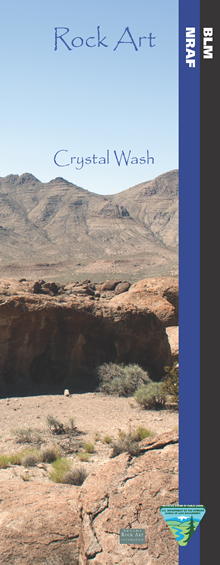Crystal Wash
Pahranagat Valley, with its springs and marshes, is an oasis in southeastern Nevada’s otherwise arid landscape. Dependable water promoted favorable habitats for plants and animals, making the valley a rich environment for prehistoric hunter-gatherers. It is no surprise that evidence of hunter-gatherer settlement abounds in Pahranagat Valley, accompanied by some of Nevada’s most spectacular rock art.
Crystal Wash I and II rock art sites are representative of this enigmatic monument made by Native Americans cultures. The two sites, approximately a quarter of a mile apart, are connected by the channel of Crystal Wash. These sites illustrate the co-mingling of everyday life with a symbolism (the use of imagery to convey ideas and beliefs) that expressed important cultural knowledge.
Rock art is an intriguing record of ancient cultures that embellishes the tuff outcrops of the Crystal Wash area. Here prehistoric hunter-gatherers also camped, gathered plants, and hunted game. Hunter-gatherers relied on deep knowledge of the environment to schedule seasonal movements to places where the plants and animals they depended upon would be abundant.
The Crystal Wash area was used by hunter-gatherers from around 6,000 years ago to the time that Euro-American settlers entered Pahranagat Valley in the mid-nineteenth century. Crystal Wash is thought to be a winter village site that was used by the Pahranagat Paiute people, a regional group of the Southern Paiute.
The Cystal Wash area contains a few examples of the Pahranagat Style but most of the rock art here is Basin and Range tradition in style. This comprises curvilinear and recilinear abstract designs, as well as striking portrayals of animals such as bighorn sheep, deer, and coyotes.
Rock art, settlement, and economic activities are intertwined in the Cystal Wash area. Many rock art sites are accompanied by the remains of campsites and foraging activities. Rock-shelters, middens, stone tools, and fragments of tools show that animals and plants were often processed in the vicinity of rock art. Were people drawn to the area by seasonally by available resources, or did the area have a special social and cultural significance, marked by rock art, that explains why hunter-gatherers visited the area? The exact meanings and cultural significance of Crystal Wash's rock art and its landscape may be unknowable, but these cultural marks indicate the area was important to the peoples who used these galleries of ancient art.
This webpage and the brochure were produced by NRAF with the assistance of a grant from the Lincoln County Archaeological Initiative.
